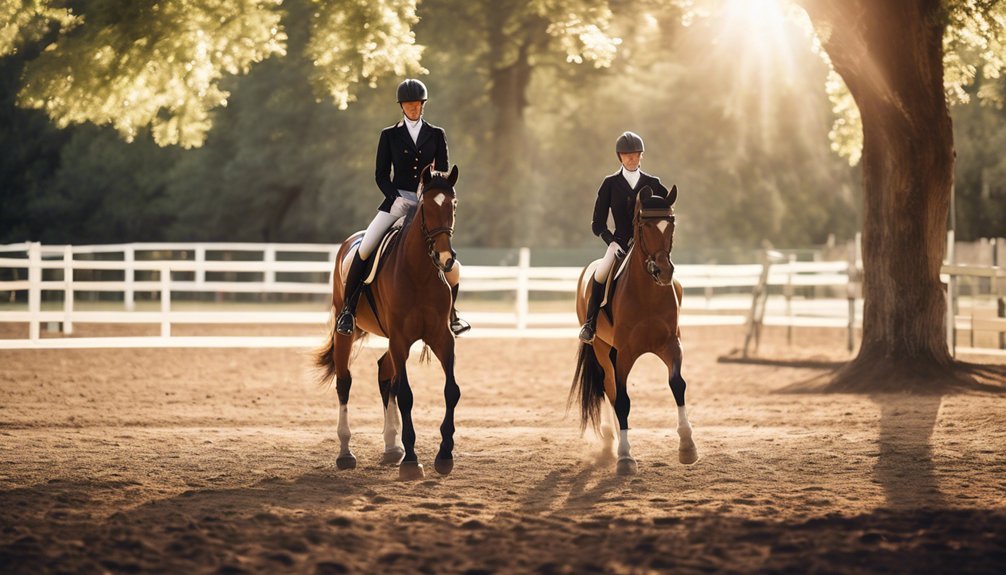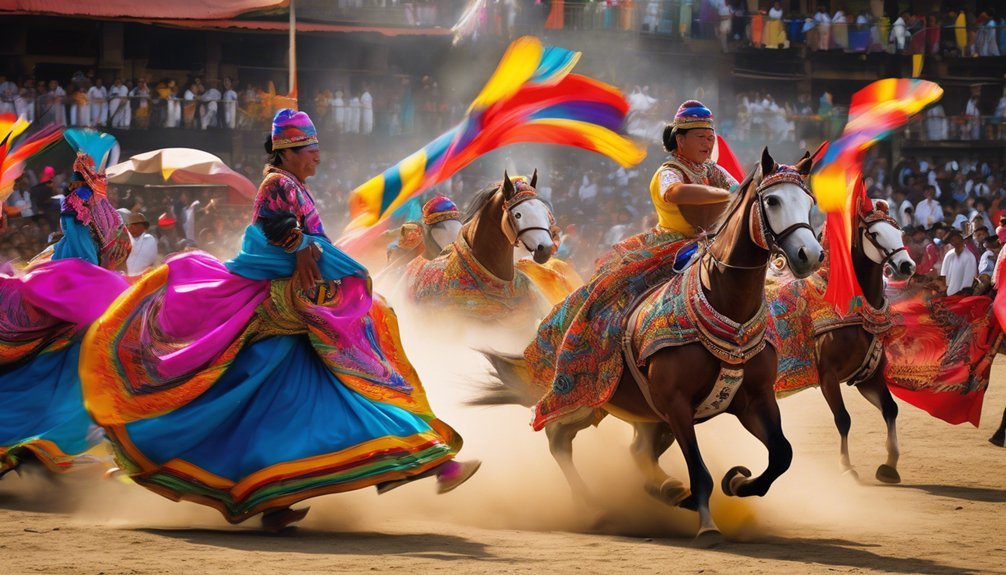
If you think riding a horse is just a leisurely activity, you might be surprised to discover how it reshapes your posture and strengthens your core. As you navigate the horse's movements, your body instinctively adjusts, engaging muscles you may not even realize are at work. This dynamic connection not only enhances physical stability but also fosters a deeper awareness of your body. What happens when this awareness transforms your riding experience and overall health?
Key Takeaways
- Horses promote proper body alignment, enhancing rider posture and stability through effective saddle positioning and core engagement.
- Engaging with a horse's movements cultivates core strength, as riders must adapt and stabilize their bodies dynamically.
- Different gaits challenge and refine balance, requiring riders to adjust their posture and strengthen core muscles for effective communication with the horse.
- Regular riding practice encourages awareness of body capabilities, improving overall core stability and posture through targeted muscle engagement.
- Emotional connection with horses fosters a positive mindset, enhancing mindfulness that supports both physical alignment and core strength during riding.
The Anatomy of Riding: Understanding Posture Requirements

When you mount a horse, your body's alignment becomes crucial not just for effective riding but also for your overall posture and core strength.
Proper saddle positioning plays a vital role in this alignment, ensuring that your hips, shoulders, and head align harmoniously. If the saddle isn't right, it can disrupt your balance, making it harder to maintain a stable posture.
Rider flexibility is equally important; it allows you to adapt your body to the horse's movement while keeping your core engaged. By fostering flexibility, you enhance your ability to respond to the horse's rhythm, supporting both your riding effectiveness and physical well-being.
This intimate connection between posture and movement creates a more profound bond with your horse.
The Connection Between Core Strength and Stability
Maintaining proper posture while riding directly influences your core strength, which is vital for stability. Your core stability is the foundation that supports your movements, allowing you to maintain dynamic alignment with your horse.
When your core engages, you not only enhance your riding performance but also foster a deeper connection with your equine partner.
- Feel the power of a strong center, grounding you.
- Experience the freedom that comes from balanced movement.
- Embrace the confidence that a stable core brings.
- Discover how alignment transforms your interactions.
As you cultivate core strength, you'll notice a profound shift in your stability, both in the saddle and in life, creating a harmonious relationship that enhances every ride.
How Riding Engages Core Muscles
As you ride, your core muscles engage in a complex interplay, stabilizing your body while adapting to the horse's movements.
This core muscle activation is essential, as it enhances your riding posture techniques, allowing you to maintain balance and control. You'll notice how your abdominal and back muscles work in harmony, adjusting to each stride and turn.
By focusing on your core, you not only improve your riding skills but also foster a deeper connection with your horse.
This engagement strengthens your overall posture and enhances your athleticism, making every ride more enjoyable. Embracing this dynamic interaction encourages a mindful awareness of your body, fostering both strength and grace in the saddle.
The Role of Balance in Horseback Riding

In horseback riding, maintaining balance is crucial for effective communication with your horse.
Proper body alignment and engaging your core muscles not only enhance your stability but also help develop essential equilibrium skills.
As you ride, you'll discover how these elements work together to create a harmonious connection between you and your equine partner.
Importance of Body Alignment
While you ride, the importance of body alignment becomes apparent, as it directly impacts your balance and overall performance. Achieving proper alignment requires keen body awareness and effective posture correction.
When you align your body correctly, you foster a deeper connection with your horse, enhancing both your ride and your bond.
- Feel the harmony between you and your horse.
- Experience the thrill of effortless movement.
- Discover newfound confidence in your abilities.
- Embrace the joy of riding with grace and poise.
Each ride offers a chance to refine your alignment, creating a fluid dialogue with your horse.
Prioritizing this alignment not only elevates your riding experience but also nurtures a profound understanding of your body and its capabilities.
Engaging Core Muscles
Engaging your core muscles is essential for maintaining balance while riding, and it significantly enhances your overall performance.
When you focus on core muscle engagement, you're not just stabilizing your body; you're creating a solid foundation for your riding posture adjustments. This connection between your core and the horse helps you respond to its movements more fluidly, allowing for a harmonious partnership.
As you ride, notice how activating your core can transform your stability, enabling you to maneuver with greater ease and control. This awareness fosters a deeper bond between you and your horse, enhancing both your skill and enjoyment.
Embracing core engagement isn't just about physical strength; it's a journey toward unity and balance in your equestrian experience.
Developing Equilibrium Skills
Achieving true balance on horseback requires more than just physical stability; it necessitates a keen awareness of your body's position in relation to the horse.
Developing equilibrium skills is crucial for your riding success and personal growth. Through intentional balance drills and targeted posture exercises, you can cultivate a deeper connection with your horse while enhancing your own physical presence.
- Feel the exhilarating rush of harmony with your horse.
- Experience the profound confidence that comes from balance.
- Discover the joy of fluid movements and seamless transitions.
- Embrace the intimate bond forged through shared balance.
As you practice, remember that each moment spent refining your skills brings you closer to understanding the delicate dance between rider and steed.
The Impact of Different Gaits on Body Alignment
As you explore the different gaits of your horse, you'll notice how each one uniquely influences your body alignment.
The walk promotes gentle postural benefits, while the trot engages your core in dynamic ways.
Meanwhile, the canter challenges your balance and stability, highlighting the intricate relationship between equine movement and your own physical alignment.
Walk: Gentle Alignment Benefits
While you may not realize it, the gentle rhythm of a horse's walk can significantly enhance your body alignment and core strength. This soothing gait promotes a natural posture alignment that resonates with your own body's needs.
As you engage with this gentle walk, you may discover:
- A deeper connection to your core muscles
- Heightened awareness of your body's balance
- A sense of relaxation that eases tension
- Improved posture that feels effortless and aligned
These elements work together to create a transformative experience, fostering both physical and emotional well-being.
Embracing the gentle movement of the horse encourages you to realign with your own body, nurturing a harmony that can profoundly impact your daily life.
Trot: Core Engagement Dynamics
The trot introduces a dynamic shift in how your body engages with movement, emphasizing core strength and stability.
As you rise and fall with the horse, you'll feel the trot dynamics activating your core muscles in ways that challenge and enhance your body alignment. This rhythmic motion requires you to maintain a centered posture, drawing your focus inward.
You're not just riding; you're developing an intimate connection between your core and the horse's movement. Engaging your core effectively not only stabilizes your body but also improves your overall balance and control.
The more you practice this gait, the more attuned you become to the intricate interplay of your body's mechanics, fostering a deeper awareness of your physical presence.
Canter: Balance and Stability
Transitioning from the trot to the canter significantly alters your body's engagement with movement, demanding a refined sense of balance and stability. The canter dynamics require you to adapt your posture, allowing for a deeper connection with your horse.
As you embrace this rhythm, you'll discover essential balance techniques that enhance your riding experience and strengthen your core.
- Feel the exhilarating freedom of movement.
- Embrace the challenge of maintaining your center of gravity.
- Experience the profound connection between horse and rider.
- Revel in the journey of self-discovery through balance.
Mastering the canter isn't just about speed; it's a dance of alignment and awareness that resonates within you, supporting both your physical and emotional growth.
Therapeutic Benefits of Equine Interaction
Engaging with horses offers profound therapeutic benefits that extend beyond mere companionship. Equine therapy fosters emotional bonding, allowing you to connect deeply with these majestic creatures. This connection can lead to significant improvements in mental well-being, reducing anxiety and depression. As you interact with horses, you develop trust, empathy, and self-awareness, enriching your emotional landscape.
| Therapeutic Benefits | Description |
|---|---|
| Emotional Regulation | Horses respond to your emotions, helping you become more aware of your feelings. |
| Stress Reduction | The calming presence of horses can alleviate stress and promote relaxation. |
| Improved Self-Esteem | Interacting with horses fosters a sense of accomplishment and boosts confidence. |
| Enhanced Social Skills | Engaging with horses facilitates communication and social interaction. |
These benefits create a holistic healing experience that nurtures both body and spirit.
Exercises to Complement Riding for Improved Posture

To improve your posture while riding, incorporating specific exercises can make a significant difference in your overall performance and comfort.
Focus on a balanced routine that strengthens your core and enhances flexibility.
- Engaging in stretching routines to promote muscle relaxation and lengthening
- Committing to strengthening exercises that activate your core and back muscles
- Practicing balance drills to improve stability in the saddle
- Integrating flexibility training for a more fluid, graceful posture
Regular posture assessments can help you track progress while coordination techniques refine your movements.
Embrace core workouts to ensure muscle activation supports your riding.
With dedication, these exercises can empower you, creating a deep connection between you and your horse.
The Psychology of Riding and Its Effects on Body Awareness
As you ride, your mental state heavily influences your body awareness and posture, often determining how effectively you connect with your horse.
When you cultivate mental focus, you become more attuned to your body's movements. This heightened awareness allows you to find balance and maintain a strong core, ultimately enhancing your riding experience.
Your emotional connection with the horse also plays a crucial role; it can either ground you or distract you. By fostering a positive mindset and embracing the bond you share, you can navigate each ride with intention.
This synergy between your mental state and physical posture not only improves your riding but deepens your relationship with your horse, creating a harmonious partnership that thrives on mutual understanding.
Common Postural Issues in Riders and How to Address Them
Riders often encounter a variety of postural issues that can hinder both their performance and the connection with their horse.
These common injuries and rider fatigue often stem from muscle imbalances and poor alignment. To address these challenges, consider the following approaches:
- Engage in regular posture assessments to identify weaknesses.
- Incorporate strength training to build core stability.
- Prioritize flexibility training to enhance range of motion.
- Focus on refining riding techniques for better alignment.
Long-Term Benefits of Horseback Riding on Physical Health

While many people view horseback riding as a leisurely activity, it offers substantial long-term benefits for physical health that often go overlooked. Engaging in this dynamic sport enhances your core strength and promotes better posture, leading to improved balance and stability in everyday life.
As you ride, your body develops long-term endurance, allowing you to engage in various physical activities with greater ease. The rhythmic movements and natural engagement of muscles while riding can significantly reduce stress and improve mental well-being, making it a holistic approach to fitness.
Frequently Asked Questions
How Does Horseback Riding Affect Mental Health and Well-Being?
Horseback riding fosters emotional connection and promotes mental well-being through therapeutic riding. You experience a unique bond with the horse, enhancing your mood, reducing anxiety, and cultivating a sense of peace and belonging within yourself.
Can Riding Improve Flexibility and Range of Motion in Riders?
Riding can enhance your flexibility benefits and increase your range of motion. The rhythmic movements and engagement of various muscle groups foster a deeper connection to your body, promoting overall physical wellness and a sense of freedom.
What Age Is Appropriate for Children to Start Riding Lessons?
While some kids may seem ready at five, others might thrive better starting at eight. Age recommendations vary, but true riding readiness often depends on individual maturity and ability to follow instructions, ensuring a safe experience.
Are There Specific Breeds of Horses That Enhance Rider Posture?
Certain horse breeds, like warmbloods, excel in dressage and naturally promote better rider posture. Their balanced movements foster core engagement, allowing you to develop strength and alignment, enhancing your overall riding experience and connection.
How Can I Prevent Saddle Sores While Improving My Riding Posture?
To keep discomfort at bay while enhancing your riding posture, ensure proper saddle fit and adopt effective riding techniques. You'll find that these adjustments not only elevate your experience but also nurture a deeper connection with your horse.
Conclusion
In the dance between horse and rider, your posture becomes the melody, while core strength serves as the rhythm. Just as a skilled musician adapts to the nuances of their instrument, you learn to align your body with the horse's movements, fostering a deeper connection and awareness. This partnership not only enhances your physical abilities but also nurtures emotional harmony. Embrace this journey, for every ride is a step toward a stronger, more balanced you, both on and off the saddle.





